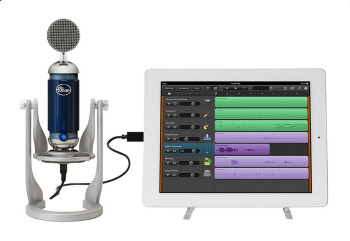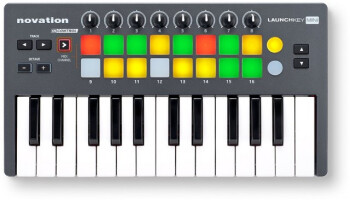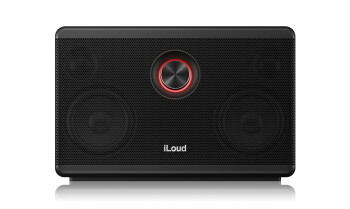In part 1, we looked at choosing a bus-powered audio interface to use for connecting microphones, instruments and MIDI controllers to your iPad. In this second installment, we'll look at an alternative approach for equipping your studio for audio and MIDI input, as well as other components you'll need to complete your mobile setup.
(Read Part 1 here)
The à la carte method
That other approach entails equipping your studio with the individual components that connect directly or through a USB adapter to your iOS device. These might include a dedicated iOS or USB mic for vocals and acoustic-instrument miking, an iOS or USB MIDI keyboard (or MIDI adapter) for MIDI parts, and a dedicated iOS instrument interface for DI parts.
If you don’t care about having multiple simultaneous inputs, and plan on only recording one track at a time, it might make sense to go this route. It will mean that you have more individual components in your studio, but most are quite small, and you might even end up with a smaller and lighter setup.
Mic choices
With an audio interface, you’ll be able to use any XLR mic, which gives you an enormous set of choices and means you can also use a mic you already own. But if you’re eschewing an interface, you could go with an iOS-compatible mic that plugs directly into your device’s dock connector, such as the Apogee MiC 96K ($229), the Blue Microphones Spark Digital ($199), or the IK Multimedia iRig Mic HD ($99.99). You can save money by getting an iOS mic that connects through the headphone jack of your device (and includes its own headphone jack so you can hear yourself), but you’ll be sacrificing some fidelity compared to a dock-connected mic.
|
Spark Digital from Blue Microphones offers direct connection to your iOS device.
|
Another dedicated mic option is a USB mic, connected to your device using the appropriate Apple camera connection adapter (mentioned in part 1). There are lots of USB mics on the market, with a pretty wide range of quality and price.
In addition, there are several stereo iOS mics on the market, such as the Røde Microphone iXY ($149), the Zoom iQ5 ($99.99), the Blue Microphones Mikey Digital ($99.99) and the Tascam iM2X ($79.99). While a stereo mic is great for videos, field recording and concerts, you probably want a mono model as your primary studio mic, so you can use standard studio miking techniques. One of these stereo mics would be quite handy, however, to have as a secondary, specialty mic for your mobile rig.
One other option is the IK Multimedia iRig Pre ($39.99), which is a dedicated, pocket-sized mic preamp with phantom power. It allows you to connect any XLR mic to your iOS device.
You’ll also need a microphone stand, but for ultimate portability you’ll probably want something smaller and easier to carry than a standard mic stand. Perhaps the best bet is to get a desktop stand. It’s not a perfect solution, but if you don’t mind singing while you’re seated, it could work.
Instrument interfaces
If you’re going the à la carte route, and need a dedicated interface for DI guitar and bass, there are plenty of choices. These range from products that plug in through the headphone jack to ones that go through the dock. Like with mics, you’ll do better fidelity-wise with the dock-connected accessories, such as Apogee’s high resolution Jam 96K ($129) or Jam ($99), Peavey Ampkit LiNK HD $119.99 for Lightning, $99.99 for 30-pin), Line 6 Sonic Port ($99.95), Sonoma Wireworks Guitar Jack 2 Model 2 ($99) and IK Multimedia iRig HD ($99.99). If you don’t mind a slightly less pristine signal, one of the jack-connected interfaces, such as the Griffin Guitar Connect ($29.99) or Positive Grid JamUp Plug ($19.99) can save you significant bucks.
MIDI keyboards
Whether you’re using an audio interface with a MIDI port, or going with separate dedicated devices, you want the keyboard for your mobile studio to be small. Unless you use an iOS compatible keyboard, like the IK Multimedia iRig KEYS ($129.99 for Lightning version, $99.99 for 30-pin), you’re likely to be connecting your controller either through a MIDI jack on your audio interface, any MIDI keyboard through a dedicated iOS MIDI interface (like the Line 6 MIDI Mobilizer II or IK Multimedia iRig MIDI, both $69.99) or a USB MIDI keyboard connected through one of Apple’s iPad USB camera adapters (not available for iPhones or iPod touches).
|
The Novation Launchkey Mini offers mini-keys, 16 pads, and 8 knobs, all in a very compact footprint.
|
If you want your setup to be truly mobile, you’ll probably want to opt for a USB keyboard with mini-keys, such as the Novation Launchkey Mini ($99.99), or the Akai Professional LPK 25, the Korg NanoKEY 2 ($49.99), M-Audio Axiom AIR Mini 32 ($99.99), the Keith McMillen Instruments QuNexus ($149) or the aforementioned iRig KEYS.
In the mix
Finally, you’re going to need a way to listen to what you’re recording. Obviously, you’ll want headphones for recording and mixing. Here’s an area where you should spend some extra bucks, if possible, to get a pair designed for flat response, which will be crucial for both mixing and getting sounds with a microphone when tracking.
For mixing, it’s best to also have studio monitors, but even small active models are quite heavy and bulky and need AC power. The only portable, battery-powered speaker currently on the market is the IK Multimedia iLoud ($299.99), which offers both Bluetooth and wired operation and runs on a rechargeable battery. There are plenty of other portable stereo speakers available, but they’re designed to make music sound good, and not to provide the flat response you need for mixing.
Hit the road, Jack
As this two-part article has shown, putting together a high-quality, battery-powered mobile studio is now quite doable. With such a rig, you can record in your hotel room, on a tour bus, at the beach, or anywhere your music takes you.





